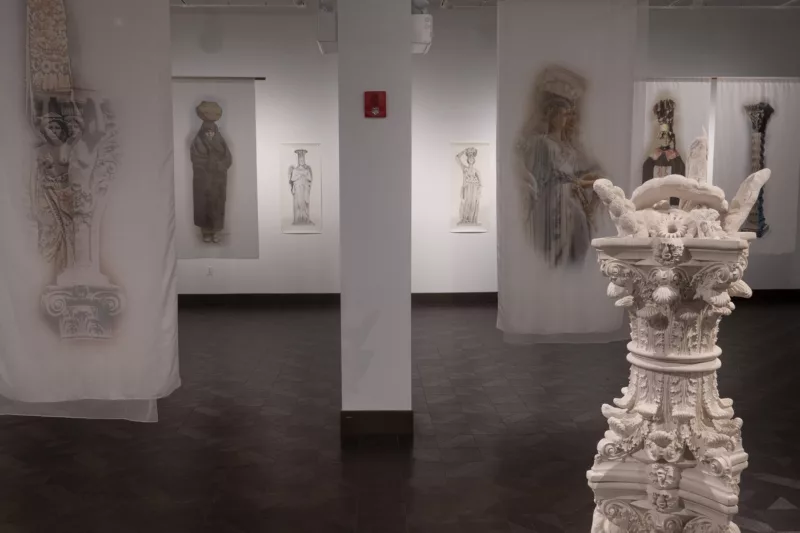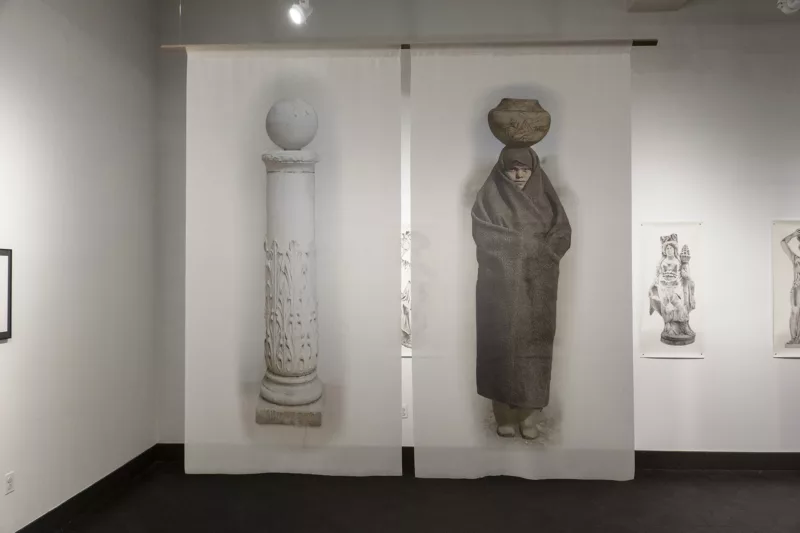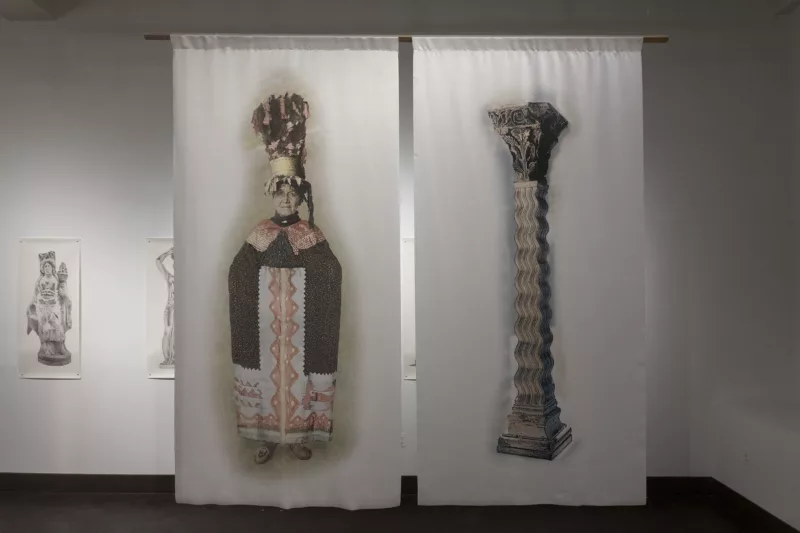
In her new show, The Lightness of Bearing, at Rowan University Art Gallery until Oct. 28, Virginia Maksymowicz uses the iconic image of the caryatid in various ways and in differing materials as a thread connecting ancient and contemporary practices regarding the central place of women in human social networks.
Caryatids are stone-carved, vertical, draped female figures that act as columns to support the entablature of Greek architecture. Caryatids embody a contradiction: even as they display symbolic and actual strength, they also posit an ideal of feminine perfection and grace in their posture and form – a kind of “lightness of bearing”, if you will. Rodin’s “Fallen Caryatid Carrying Her Stone” expresses through her contorted form the pressure on women to meet these moral expectations of purity, righteousness, and perfection.

Maksymowicz has used these caryatid figures throughout the show as icons of a social-cultural anthropology, pairing them with contemporary images of ethnic and Indigenous women carrying baskets of bread on their heads to explore how shared systems of ideas relate to the structured ways that people interact in society.
In “The Comparisons,” seven sets of paired images printed on translucent fabric scrolls hang from dowels above, each set including a grisaille caryatid image and a contemporary, minimally colored image of a woman bearing bread, baskets of elaborate flower structures, or water on their head. The womens’ verticality and supportive structure echoes that of the caryatids: together conveniently they create a hybrid image from the simultaneous viewing of the two separate but superimposed figures. The scale of these works is almost life-size, and their material translucency coupled with the images of weight create not only the experience of encountering another “human”, but also, strangely, the opposite: the uncanny experiential residue of disembodied figures.
Similar pairings of superimposed images appear in other works, most notably as vignettes in a set of five sculptural books, “Caryatids in Five Books,” which together spell out a poem by the contemporary poet Cristina-Monica Moldoveanu that alludes to feminine childhood experience and the place of imagination as sustenance for the creative life.

Another kind of sustenance – the bread contained in the baskets – is further explored in a short, compilation documentary video capturing the myriad cultural rituals surrounding bread: in one, young women dressed completely in white, as if receiving their First Communion (the “Body of Christ” or “Panis Angelicus” in Catholic tradition) balance large, elaborate white-trimmed baskets of bread on their heads while processing to a local senior center to distribute it and converse with the residents. This ritualized action of women bringing and breaking bread creates and sustains community. Other works in the show echo the conflation of earthly and spiritual bread, most notably “Panis Angelicus” (“Bread of Angels”), a large, central 3D sculpture combining putti with various bread shapes cast from loaves.
The idea of things seen through other things – as in “The Comparisons” – is also at play here as ancient cultures are seen anew through contemporary rituals, and our own expressions are given new meaning when seen against those of the past. At a time when we are so focused on the dubious future of humanity, from our possible extinction via climate change, violence, and war to our gradual replacement with 3D laser-cut body parts and genetically manipulated DNA, it’s refreshing to see work about our past: it extends and broadens the context for considering what it means to be human at any given time. What are the “big ideas” that recur throughout human history? How do they change over time? What connects us to past human experience, and how do we express that connection? This show wisely does not answer the question, but it offers possibilities for the long haul by way of myth, ritual, and sustenance.
Virginia Maksymowicz, “The Lightness of Bearing” at Rowan University Art Gallery, until Oct. 28, 2023.









